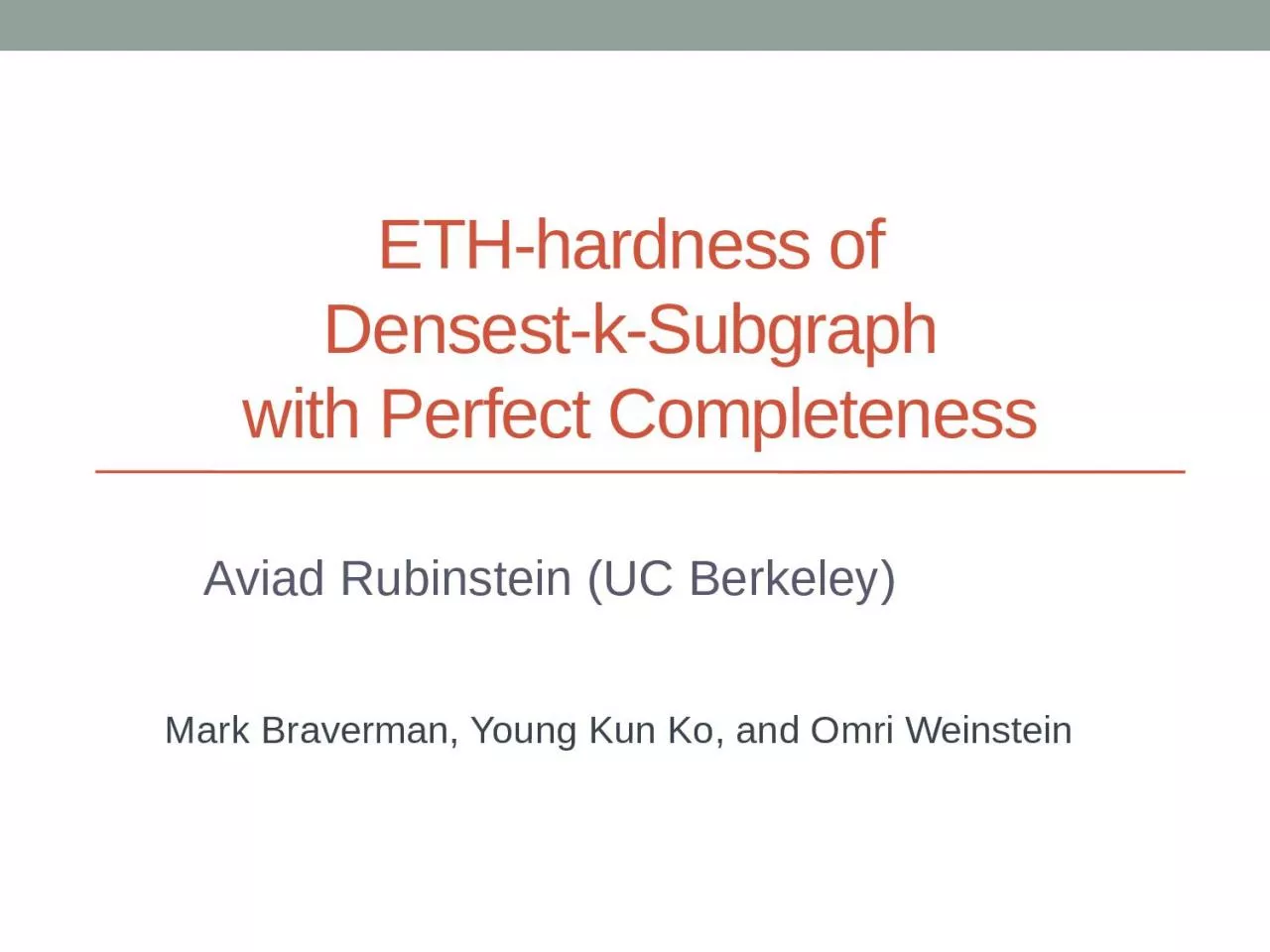

Subgraph with Perfect Completeness Aviad Rubinstein UC Berkeley Mark Braverman Young Kun Ko and Omri Weinstein A confession rest of workshop this talk vs vs SETH SAT requires ID: 1001160
Download Presentation The PPT/PDF document "ETH-hardness of Densest-k-" is the property of its rightful owner. Permission is granted to download and print the materials on this web site for personal, non-commercial use only, and to display it on your personal computer provided you do not modify the materials and that you retain all copyright notices contained in the materials. By downloading content from our website, you accept the terms of this agreement.
1. ETH-hardness of Densest-k-Subgraph with Perfect CompletenessAviad Rubinstein (UC Berkeley)Mark Braverman, Young Kun Ko, and Omri Weinstein
2. A confession…rest of workshopthis talk vs vs SETH: SAT requires ETH: SAT requires Reduction size: Reduction size: rest of workshopthis talkthis talk isn’t really about low-polynomial time(and this isn’t really Grandma)
3. Densest k-Subgraphwith perfect completeness
4. k-CLIQUEG|S|=kdoes G contain a k-clique?(NP-hard [Karp72])
5. relax “k”?G|S|≥kNP-hard [FGLSS96 … Zuckerman07]vsG|S| < k/n1-ε
6. relax “clique”?G|S|=kQuasi-poly algorithms [FS97, Barman15]vsG|S|=kden(S)=1den(S)<1-δ
7. relax both?G|S|≥kOur main result: ETH-hardvsGden(S) = 1|S| < k/nε/loglognden(S) < 1-δ
8. related works on “sparse vs very sparse”GvsGden(S)≥c(n)den(S)<s(n)0<s(n)<c(n)≪1[Feige02, AAMMW11] – random k-CNF[BCVGZ12] – SDP relaxations[RS10] – Unique Games with expansion
9. Main technique: Birthday Repetition
10. Recent applications of B-day RepQuasi-poly time hardness for…[AIM14]: AM with k provers (“something quantum”)Dense CSP’sFree games[BKW15]: ε-best ε-Nash[BPR16]: ε-Nash[R15] / [BCKS]: Signaling[this talk]: Densest k-Subgraph[ you! ]: ???
11. Recent applications of B-day RepQuasi-poly time hardness for…[AIM14]: AM with k provers (“something quantum”)Dense CSP’sFree games[BKW15]: ε-best ε-Nash[BPR16]: ε-Nash[R15] / [BCKS]: Signaling[this talk]: Densest k-Subgraph[ you! ]: graph isomorphism??
12. Recent applications of B-day RepQuasi-poly time hardness for…[AIM14]: AM with k provers (“something quantum”)Dense CSP’sFree games[BKW15]: ε-best ε-Nash[BPR16]: ε-Nash[R15] / [BCKS]: Signaling[this talk]: Densest k-SubgraphTight by [FS97], [LMM03], [Barman15], [MM15], [CCDEHT15], etc.
13. Reduction in 1 slidevariablesxiconstraints Reduction from 2CSP (e.g. 3COL)
14. Birthday Paradox: every pair (u,v) should test a constraintAnalysis (soundness) in 1 slideIf every assignment to 2CSP violates -fraction of the constrains,the corresponding k-subgraph should be missing -fraction of edges.QED? what about k-subgraphs that don’t correspond to any assignment?
15. Not so simple…“Typically” birthday repetition is easy Queries to Alice and Bob are independent.More subtle for Densest k-Subgraph…Very simple problem – hard to enforce structurewe only know that the subgraph is large + dense“like proving a parallel repetition theorem,when Alice and Bob choose which queries to answer”If it were easy, we would get hardness for den(S)=1 vs den(S)=δ
16. So what can we do?“Typically” birthday repetition is easy Queries to Alice and Bob are independent.More subtle for Densest k-Subgraph…Very simple problem – hard to enforce structurewe only know that the subgraph is large + dense“like proving a parallel repetition theorem,when Alice and Bob choose which queries to answer”If it were easy, we would get hardness for den(S)=1 vs den(S)=δ
17. Analysis in 1 slide: “counting entropy”G|S|=k choice of variableschoice of assignments many CSP violations!many consistencyviolations!low density,QED!
18. Open problems“Warmup”: same result for Densest k-Bi-SubgraphDen(S)=1 vs den(S)=δStronger (NP?) hardness for “sparse vs very sparse”Fixed parameter (k) tractability?